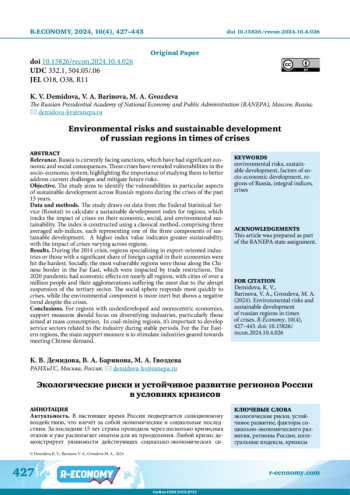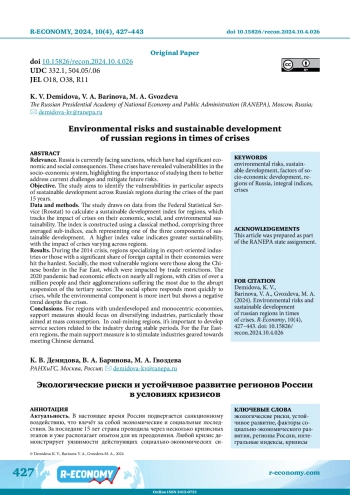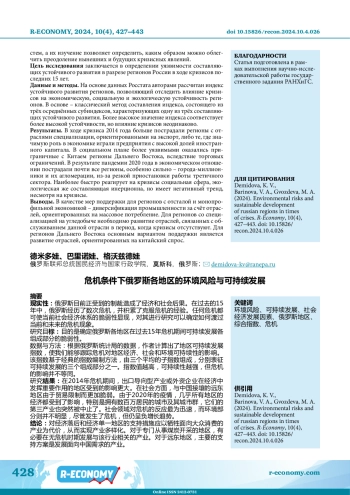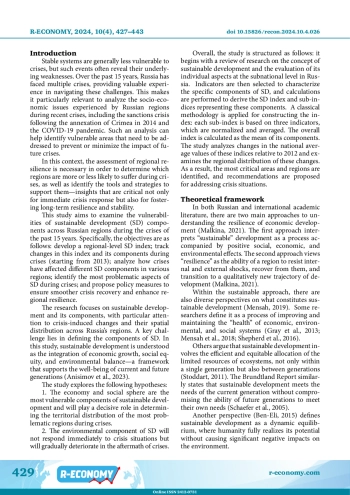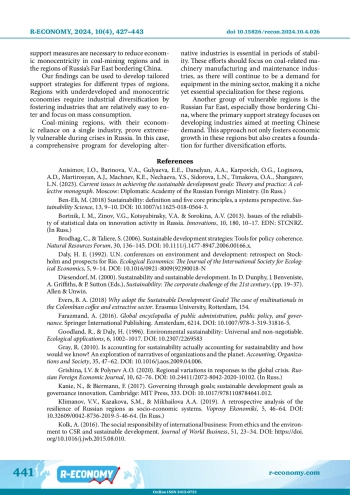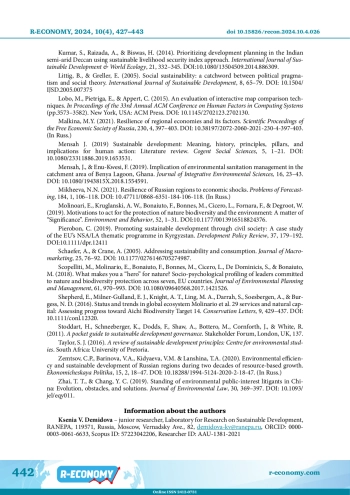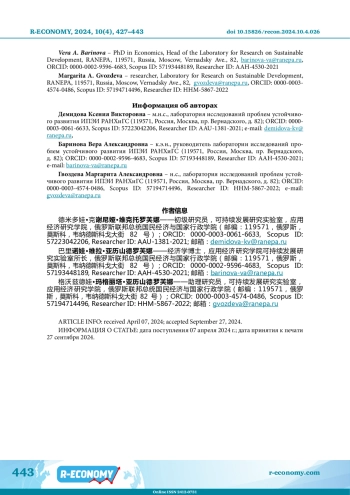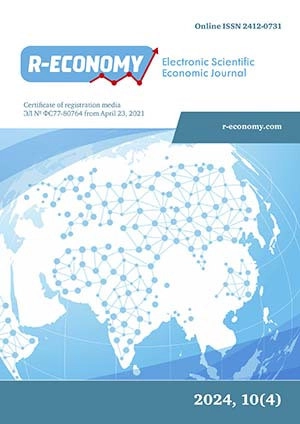Relevance. Russia is currently facing sanctions, which have had significant economic and social consequences. These crises have revealed vulnerabilities in the socio-economic system, highlighting the importance of studying them to better address current challenges and mitigate future risks. Objective. The study aims to identify the vulnerabilities in particular aspects of sustainable development across Russia’s regions during the crises of the past 15 years. Data and methods. The study draws on data from the Federal Statistical Service (Rosstat) to calculate a sustainable development index for regions, which tracks the impact of crises on their economic, social, and environmental sustainability. The index is constructed using a classical method, comprising three averaged sub-indices, each representing one of the three components of sustainable development. A higher index value indicates greater sustainability, with the impact of crises varying across regions. Results. During the 2014 crisis, regions specializing in export-oriented industries or those with a significant share of foreign capital in their economies were hit the hardest. Socially, the most vulnerable regions were those along the Chinese border in the Far East, which were impacted by trade restrictions. The 2020 pandemic had economic effects on nearly all regions, with cities of over a million people and their agglomerations suffering the most due to the abrupt suspension of the tertiary sector. The social sphere responds most quickly to crises, while the environmental component is more inert but shows a negative trend despite the crises. Conclusions. For regions with underdeveloped and monocentric economies, support measures should focus on diversifying industries, particularly those aimed at mass consumption. In coal-mining regions, it’s important to develop service sectors related to the industry during stable periods. For the Far Eastern regions, the main support measure is to stimulate industries geared towards meeting Chinese demand.
Идентификаторы и классификаторы
Stable systems are generally less vulnerable to crises, but such events often reveal their underlying weaknesses. Over the past 15 years, Russia has faced multiple crises, providing valuable experience in navigating these challenges. This makes it particularly relevant to analyze the socio-economic issues experienced by Russian regions during recent crises, including the sanctions crisis following the annexation of Crimea in 2014 and the COVID-19 pandemic. Such an analysis can help identify vulnerable areas that need to be addressed to prevent or minimize the impact of future crises.
In this context, the assessment of regional resilience is necessary in order to determine which regions are more or less likely to suffer during crises, as well as identify the tools and strategies to support them—insights that are critical not only for immediate crisis response but also for fostering long-term resilience and stability
Список литературы
1. Anisimov I. O., Barinova V. A., Gulyaeva E. E., Danelyan A. A., Karpovich O. G., Loginova A. D., Martirosyan A. J., Machnev K. E., Nechaeva Y. S., Sidorova L. N., Timakova O. A., Shangarev L. N. (2023). Current issues in achieving the sustainable development goals: Theory and practice: A collective monograph. Moscow: Diplomatic Academy of the Russian Foreign Ministry. (In Russ.). EDN: FVMSCF
2. Ben-Eli M. (2018) Sustainability: definition and five core principles, a systems perspective. Sustainability Science, 13, 9-10. DOI: 10.1007/s11625-018-0564-3 EDN: GXQDIA
3. Bortnik I. M., Zinov V. G., Kotsyubinsky V. A., Sorokina A. V. (2013). Issues of the reliability of statistical data on innovation activity in Russia. Innovations, 10, 180, 10-17. (In Russ.). EDN: STCNRZ
4. Brodhag C., Taliere S. (2006). Sustainable development strategies: Tools for policy coherence. Natural Resources Forum, 30, 136-145. DOI: 10.1111/j.1477-8947.2006.00166.x
5. Daly H. E. (1992). U.N. conferences on environment and development: retrospect on Stockholm and prospects for Rio. Ecological Economics: The Journal of the International Society for Ecological Economics, 5, 9-14. DOI: 10.1016/0921-8009(92)90018-N
6. Diesendorf M. (2000). Sustainability and sustainable development. In D. Dunphy, J. Benveniste, A. Griffiths, & P. Sutton (Eds.), Sustainability: The corporate challenge of the 21st century, (pp. 19-37). Allen & Unwin.
7. Evers B. A. (2018) Why adopt the Sustainable Development Goals? The case of multinationals in the Colombian coffee and extractive sector. Erasmus University, Rotterdam, 154.
8. Farazmand A. (2016). Global encyclopedia of public administration, public policy, and governance. Springer International Publishing. Amsterdam, 6214. DOI: 10.1007/978-3-319-31816-5 EDN: IRMMXC
9. Goodland R., Daly H. (1996). Environmental sustainability: Universal and non-negotiable. Ecological applications, 6, 1002-1017. DOI: 10.2307/2269583
10. Gray R. (2010). Is accounting for sustainability actually accounting for sustainability and how would we know? An exploration of narratives of organizations and the planet. Accounting, Organizations and Society, 35, 47-62. DOI: 10.1016/j.aos.2009.04.006
11. Grishina I. V. Polynev A. O. (2020). Regional variations in responses to the global crisis. Russian Foreign Economic Journal, 10, 62-76. (In Russ.). DOI: 10.24411/2072-8042-2020-10102 EDN: ZZJCNQ
12. Kanie N., Biermann F. (2017). Governing through goals; sustainable development goals as governance innovation. Cambridge: MIT Press, 333. DOI: 10.1017/9781108784641.012
13. Klimanov V. V., Kazakova S. M., Mikhailova A. A. (2019). A retrospective analysis of the resilience of Russian regions as socio-economic systems. Voprosy Ekonomiki, 5, 46-64. (In Russ.). DOI: 10.32609/0042-8736-2019-5-46-64 EDN: VBEOOY
14. Kolk A. (2016). The social responsibility of international business: From ethics and the environment to CSR and sustainable development. Journal of World Business, 51, 23-34. DOI: 10.1016/j.jwb.2015.08.010
15. Kumar S., Raizada A., Biswas H. (2014). Prioritizing development planning in the Indian semi-arid Deccan using sustainable livelihood security index approach. International Journal of Sustainable Development & World Ecology, 21, 332-345. DOI: 10.1080/13504509.2014.886309
16. Littig B., Greller E. (2005). Social sustainability: a catchword between political pragmatism and social theory. International Journal of Sustainable Development, 8, 65-79. DOI: 10.1504/IJSD.2005.007375
17. Lobo M., Pietriga E., Appert C. (2015). An evaluation of interactive map comparison techniques. In Proceedings of the 33rd Annual ACM Conference on Human Factors in Computing Systems (pp.3573-3582). New York, USA: ACM Press. DOI: 10.1145/2702123.2702130
18. Malkina M. Y. (2021). Resilience of regional economies and its factors. Scientific Proceedings of the Free Economic Society of Russia, 230, 4, 397-403. (In Russ.). DOI: 10.38197/2072-2060-2021-230-4-397-403 EDN: JGEKYC
19. Mensah J. (2019) Sustainable development: Meaning, history, principles, pillars, and implications for human action: Literature review. Cogent Social Sciences, 5, 1-21. DOI: 10.1080/23311886.2019.1653531
20. Mensah J., Enu-Kwesi F. (2019). Implication of environmental sanitation management in the catchment area of Benya Lagoon, Ghana. Journal of Integrative Environmental Sciences, 16, 23-43. DOI: 10.1080/1943815X.2018.1554591
21. Mikheeva, N.N. (2021). Resilience of Russian regions to economic shocks. Problems of Forecasting, 184, 1, 106-118. (In Russ.). DOI: 10.47711/0868-6351-184-106-118 EDN: CAARNS
22. Molinoari E., Kruglanski A. W., Bonaiuto F., Bonnes M., Cicero L., Fornara F., Degroot W. (2019). Motivations to act for the protection of nature biodiversity and the environment: A matter of “Significance”. Environment and Behavior, 52, 1-31. DOI: 10.1177/0013916518824376
23. Pierobon C. (2019). Promoting sustainable development through civil society: A case study of the EU’s NSA/LA thematic programme in Kyrgyzstan. Development Policy Review, 37, 179-192. DOI: 10.1111/dpr.12411
24. Schaefer A., Crane A. (2005). Addressing sustainability and consumption. Journal of Macromarketing, 25, 76-92. DOI: 10.1177/0276146705274987 EDN: JNRCWB
25. Scopelliti M., Molinario E., Bonaiuto F., Bonnes M., Cicero L., De Dominicis S., Bonaiuto M. (2018). What makes you a “hero” for nature? Socio-psychological profiling of leaders committed to nature and biodiversity protection across seven, EU countries. Journal of Environmental Planning and Management, 61, 970-993. DOI: 10.1080/09640568.2017.1421526
26. Shepherd E., Milner-Gulland E. J., Knight A. T., Ling M. A., Darrah S., Soesbergen A., Burgess N. D. (2016). Status and trends in global ecosystem Molinario et al. 29 services and natural capital: Assessing progress toward Aichi Biodiversity Target 14. Conservation Letters, 9, 429-437. DOI: 10.1111/conl.12320
27. Stoddart H., Schneeberger K., Dodds F., Shaw A., Bottero M., Cornforth J., White R. (2011). A pocket guide to sustainable development governance. Stakeholder Forum, London, UK, 137.
28. Taylor S. J. (2016). A review of sustainable development principles: Centre for environmental studies. South Africa: University of Pretoria.
29. Zemtsov C. P., Barinova V. A., Kidyaeva V. M., Lanshina T. A. (2020). Environmental efficiency and sustainable development of Russian regions during two decades of resource-based growth. Ekonomicheskaya Politika, 15, 2, 18-47. (In Russ.). DOI: 10.18288/1994-5124-2020-2-18-47 EDN: WUZPOS
30. Zhai T. T., Chang Y. C. (2019). Standing of environmental public-interest litigants in China: Evolution, obstacles, and solutions. Journal of Environmental Law, 30, 369-397. DOI: 10.1093/jel/eqy011
Выпуск
Другие статьи выпуска
Relevance The growing importance of creative industries in Russia’s economy underscores the need for effective management strategies to support the reindustrialization of second-tier cities, with a focus on socio-economic growth and the preservation of local identity. Research Objective The article aims to identify key factors that influence the development and implementation of creative reindustrialization strategies in second-tier cities. Data and Methods Using econometric modeling, the study analyzed data from 50 industrial cities in Sverdlovsk and Chelyabinsk regions (2010-2024), sourced from the Federal State Statistics Service, the Ministry of Construction, Housing and Utilities, and the Presidential Grant Foundation. Results. The study identified key factors contributing to the growth of creative industries, including the expansion of creative sector companies, proximity to regional centers, increased grant applications, the presence of manufacturing enterprises, growth in local government revenue, and the development of new housing. A comprehensive set of government support measures was proposed, encompassing infrastructure development, financial assistance, educational initiatives, informational resources, and regulatory improvements. Conclusions Essential government support to creative industries should include infrastructure development, simplified administrative procedures, tax incentives, institutional and legislative backing, and export promotion. Other support measures can be tailored to the chosen management strategy and regional needs, resulting in the creation of a flexible system centered around local identity.
Relevance. Corruption remains a persistent issue in many countries, including Kazakhstan. By exploring the relationship between the socio-economic characteristics of specific regions and corruption, this research can provide a foundation for informed policy-making and targeted anti-corruption efforts and thus help mitigate its negative impact on regional development. Research Objective. The research aims to assess the impact of corruption on regional socio-economic development in Kazakhstan through the creation and application of a multifactor corruption index. Data and Methods. The study uses official statistical data on corruption offenses and regional socio-economic indicators, including industrial production, fixed asset investments, household expenditures, unemployment rates, and foreign trade volumes. A multifactor index methodology was employed, using Pearson correlation coefficients to calculate averaged absolute values of sub-indices for each indicator. Results. The study found strong correlations between corruption and socio-economic indicators in regions like East Kazakhstan, Abay, Akmola, and Kostanay. The economic structure of these regions plays a key role: East Kazakhstan and Akmola, with dominant mining industries, are more vulnerable to corruption due to public contracts and licensing. Kostanay’s agricultural sector, central to its economy, is prone to corruption in land allocation, subsidies, and procurement. The economic importance of these sectors amplifies the impact of corruption on development, strengthening the correlation. Conversely, regions with lower index values show weaker correlations in the analysis, likely due to economic diversity, incomplete data, or less effective governance mechanisms. Conclusions. The regional specificity of the interrelation between corruption and socio-economic development in Kazakhstan necessitates tailored approaches that consider the unique conditions of each region. These findings can be of interest to policymakers and other stakeholders. The proposed methodology allows for a more precise assessment of both hidden and visible corruption risks, highlighting critical areas for implementing effective anti-corruption measures.
Relevance. Technological sovereignty in the national economy cannot be achieved without a clear understanding of the state of regional industries, particularly their level of technological maturity. This crucial factor drives investment decisions and shapes regional development strategies. However, existing methods for assessing technological development often fail to account for industries’ reliance on foreign technologies and services. Research Objective. The study explores the concept of technological maturity in the context of managing regional industrial development, focusing on the case of regional industries in Russia. Data and Methods. To evaluate the technological maturity of regional industries, we propose an index derived from normalizing key indicators that capture the critical aspects of technological maturity. The normalized indicators are aggregated using the arithmetic mean. Correlation analysis was employed to identify factors influencing technological development. The study is based on official statistics from the Federal State Statistics Service (Rosstat) for 2022. Results. Technological maturity indices are calculated for Russian regions, identifying both strengths and weaknesses. Only nine regions have achieved a medium level of technological maturity, while most remain at low levels. Additionally, many regions leading in terms of technology are highly reliant on imported technologies and services, with minimal exports of domestically developed technologies. These results highlight the need for policy measures tailored to regions’ varying needs and levels of technological maturity. Conclusions The concept of technological maturity provides a strategic framework for regional industrial development that can enhance national economic competitiveness through both embracing modern technologies and ensuring technological independence. The technological maturity index provides a valuable tool for tracking key indicators of technological sovereignty in domestic industries and identifying investment priorities to strengthen it.
Relevance. Inter-municipal cooperation is an effective tool for addressing resource deficits faced by municipalities, and its importance has grown in today’s context of socio-economic instability. However, the success of such cooperation largely depends on a careful selection of partners, which raises the question of how the strength of ties between municipalities impacts their ability to collaborate effectively. Research objective. The aim of this study is to explore how the spatial characteristics of interdependence between municipalities influence their interactions and cooperation. Data and methods. The research draws on official statistical data from Russia’s Federal State Statistics Service (Rosstat), as well as information from investment passports and municipal socio-economic development strategies. The study employs spatial correlation methods, cartographic analysis, and general research techniques, including analysis and synthesis. Results. The inter-municipal relationships in Sverdlovsk Region are highly uneven, with significant disparities in the level of involvement across different areas. These relationships are predominantly concentrated around the region’s administrative center and its neighboring municipalities, while the northern and eastern parts exhibit the weakest connectivity. Municipalities in the Ekaterinburg urban agglomeration are the most active participants in joint projects, whereas those in the southwestern part of the region show less involvement. The northern and eastern areas, in particular, demonstrate minimal engagement in forming partnerships with other municipalities, highlighting a stark regional imbalance. Conclusions. The study confirms a strong link between the interdependence of municipalities and the extent of their cooperation. Factors such as territorial and socio-economic proximity play a key role, but additional drivers, such as national or regional policies, also significantly influence inter-municipal collaboration. Interestingly, a lack of resources among potential partners does not appear to impede cooperation.
Relevance. The well-being of citizens is a key focus of national policies worldwide. Kazakhstan, however, is characterized by significant regional disparities in social well-being, which necessitates targeted programs and investments to improve conditions in less developed areas. Research Objective. This study aims to develop a national adaptive social well-being index to evaluate and spatially map the regions of Kazakhstan. Data and Methods. The methodology included identifying indicators through a literature review and regional data, conducting an expert survey to weight them, and creating a social well-being index. A spatial analysis was then used to calculate the index for each region. Results. The social well-being index shows significant disparities across regions. Astana, Almaty, and Atyrau demonstrate strong social welfare, driven by economic growth and advanced social infrastructure. In contrast, Karaganda, Pavlodar, and Shymkent show lower social welfare, highlighting the need for targeted interventions and investments. Conclusion. The findings offer valuable insights for policymakers to design strategies for sustainable socioeconomic growth in Kazakhstan. The proposed index can help national and regional authorities monitor social well-being.
Relevance. The global imperative for adopting a low-carbon economy resonates worldwide, yet comprehensive assessments specific to the Russian economy remain scant. This is especially important considering the significant differences in the level of transition to sustainable development among Russian regions. Research Objective. This study aims to introduce a robust methodology for evaluating and analyzing the international trade of low-carbon goods (LCGs) across various Russian regions and assessing its effects on fuel combustion emissions. Data and Methods. Data on LCGs trade were obtained from the Federal Customs Service of Russia. In conjunction, datasets from Rosstat and the Central Bank of Russia were incorporated for comprehensive econometric modeling. The analytical framework employed Tobit and quantile regressions. Results. The study uncovers significant disparities among Russian regions regarding the intensity of low-carbon goods exports and imports. This variation highlights the diverse competencies in LCGs production, as well as differing ecological agendas and consumption patterns across regions. Additionally, the research demonstrates that, although the widespread adoption of advanced production technologies is positively correlated with increased fuel combustion emissions, a U-shaped relationship exists where higher LCGs exports are associated with reductions in fuel combustion emissions across Russian regions to a certain degree. Conclusions. This research highlights important implications for both federal and regional industrial and environmental policies. It advocates for the development of targeted incentives that encourage the adoption of low-carbon goods (LCGs) and advanced technologies. By doing so, policymakers can effectively promote sustainable development tailored to the unique needs and conditions of various regions, thereby fostering ecological resilience and economic growth across diverse regional landscapes.
Статистика статьи
Статистика просмотров за 2025 год.
Издательство
- Издательство
- УрФУ
- Регион
- Россия, Екатеринбург
- Почтовый адрес
- 620002, Свердловская область, г. Екатеринбург, ул. Мира, д. 19
- Юр. адрес
- 620002, Свердловская область, г. Екатеринбург, ул. Мира, д. 19
- ФИО
- Кокшаров Виктор Анатольевич (Ректор)
- E-mail адрес
- rector@urfu.ru
- Контактный телефон
- +7 (343) 3754507
- Сайт
- https://urfu.ru/ru
